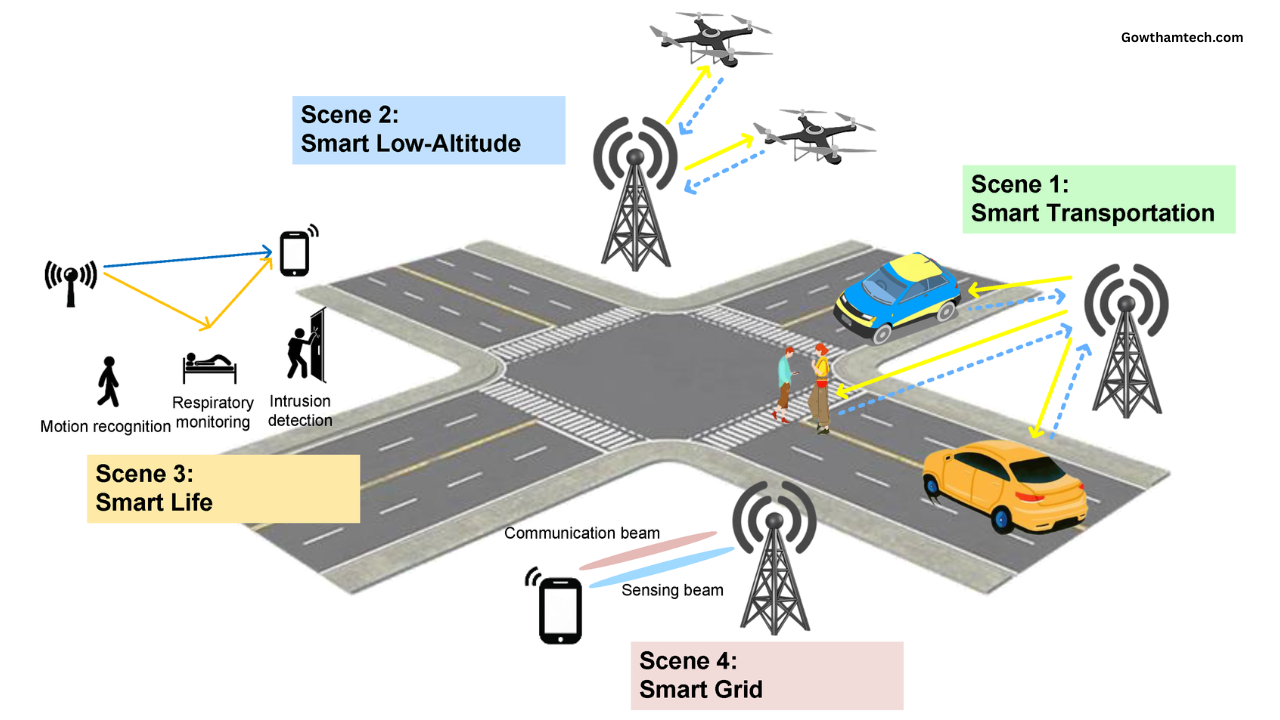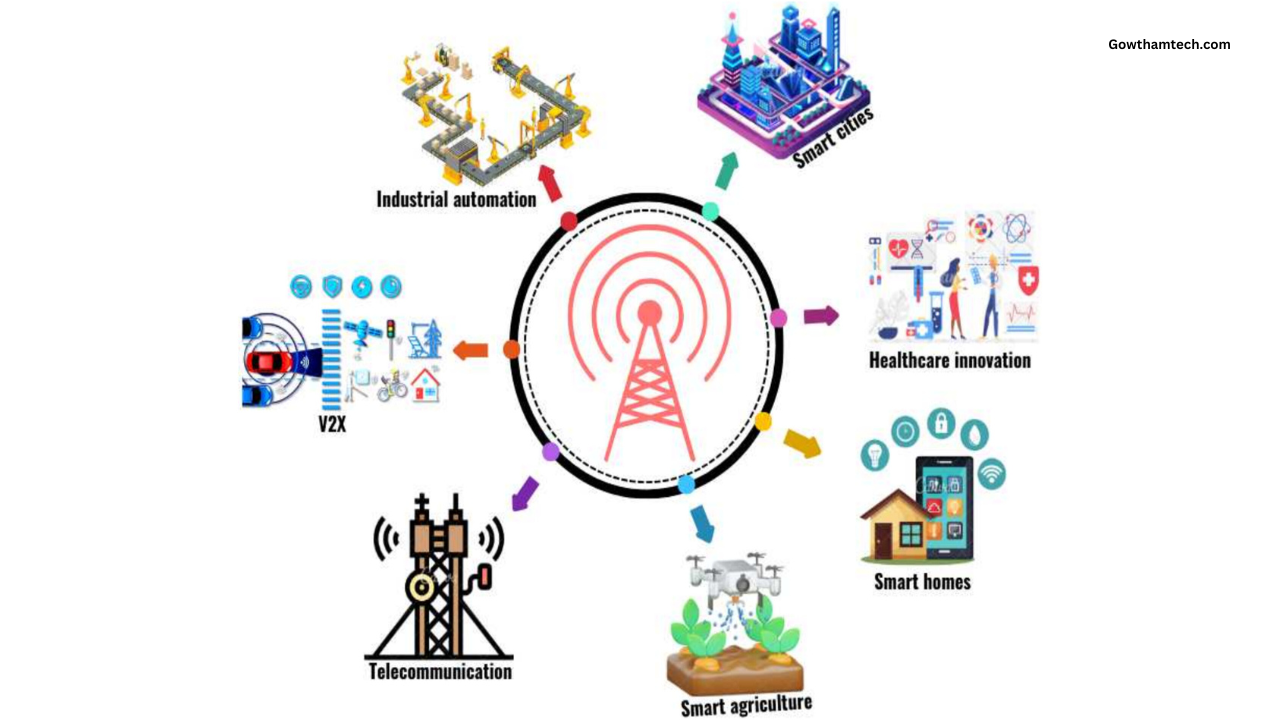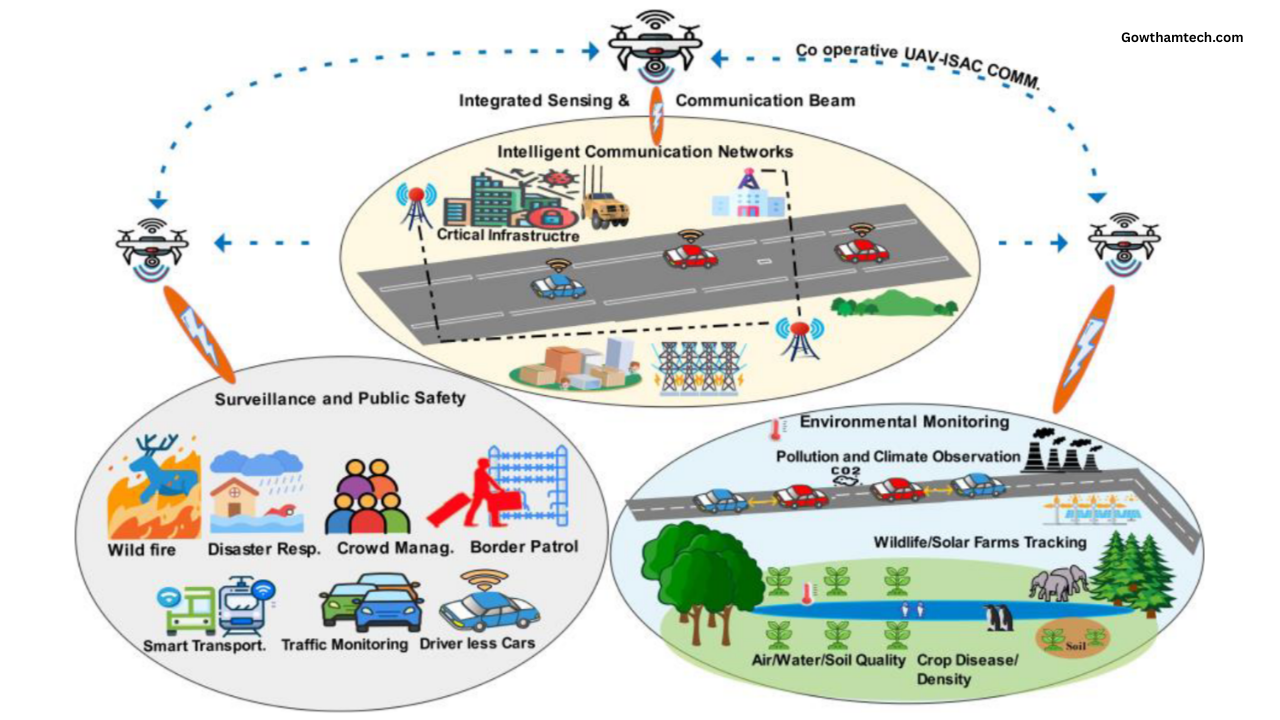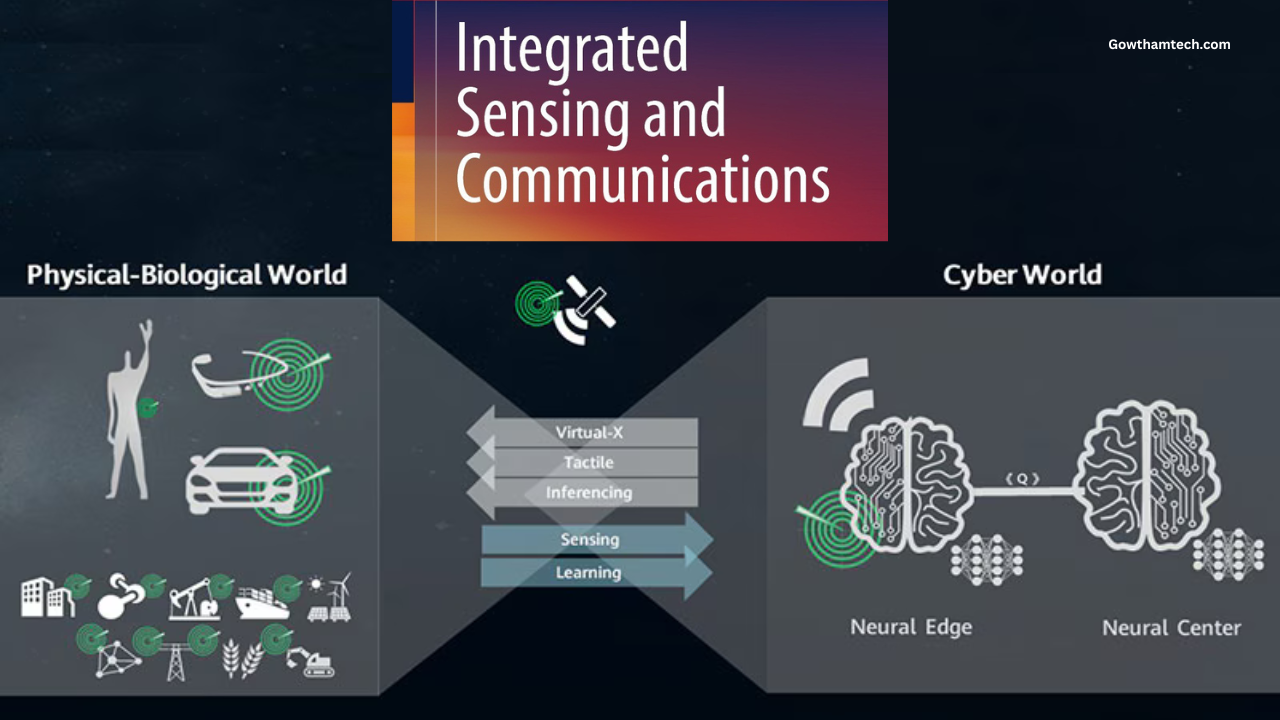The technology landscape is always changing driven by the ever growing demand for more efficient multi faceted flexible and interconnected technologies. The most intriguing trend involves the fusion of two traditionally distinct areas that are communications and sensing.
The synergy referred to as integrated Sensing and Communications is a revolutionary shift that has the potential to transform many aspects of our daily lives such as automated motoring and smart cities to the automation of industrial processes and healthcare.
In 2025 Integrated Sensing and Communications will likely to advance beyond the realm of theoretical ideas and early deployments into the mainstream that will define the next generation of wireless technology.
This document provides an extensive outline of Integrated Sensing and Communications by examining its basic principals the key enabling technologies and the anticipated application by 2025 as well as the issues and opportunities ahead.
The understanding of the future direction that will be a result of Integrated Sensing and Communications is essential for all stakeholders from all industries since it will profoundly alter the ways we communicate with the world and each other.
Fundamental Principles of Integrated Sensing and Communications
The fundamental concept behind Integrated Sensing and Communications includes the simultaneous use of communication functions and sensing functions within a single software and hardware framework. The two roles have been handled through separate software systems each with distinct spectrum as well as hardware and processing tools.
But Integrated Sensing and Communications seeks to eliminate these barriers and harness common resources in order to gain greater effectiveness lower costs as well as new capabilities. The integration may occur on different levels including using the same spectrum of radio frequencies and utilizing hardware components such as antennas and transceivers.
This can also extend into joint signal processing as well as data analysis. The advantages of this method are numerous. The efficiency of spectrum is greatly enhanced since the radio waves carry information about the environment and communication. The complexity of hardware and the cost could be decreased through sharing resources.
In addition the inherent synergy between communication and sensing can provide new functions including context aware communication and improved situational awareness. Achieving robust and effective algorithms to process signals in a joint manner is the foundation of a the success of integrated Sensing and Communications implementation.
Driving Forces Behind Integrated Sensing and Communications
A variety of key trends and technological advances are driving the rapid advancement of Integrated Sensing and Communications. The rapid growth in wireless data traffic caused by apps like video streaming games online gaming as well as the increase in Internet of Things (IoT) devices has put enormous stress on the spectrum of radio frequencies.
Integrated Sensing and Communications provides a possible solution to make the efficient use of this precious resources. In parallel the growing need for advanced sensing capabilities across various fields including autonomous vehicles that require high resolution sensors for environmental information and smart cities that require extensive surveillance requires more widespread affordable and economical sensing systems.

Integrated Sensing and Communications is able to meet this requirement through the integration of sensing functions into current or upcoming communication infrastructure. Additionally advances in technology for hardware specifically with regard to mmWave Terahertz frequencies huge MIMO as well as reconfigurable intelligent surfaces (RIS) offer the necessary components for creating highly performance integrated Sensing as well as Communications technology.
Artificial intelligence (AI) and machine learning (ML) is also essential and will allow the creation of algorithms that are intelligent for jointly processed signals as well as data fusion and the adaptive allocation of resources in integrated Sensing and Communications. This combination creates Integrated Sensing and Communications an exciting direction for the future of wireless technology.
Key Enabling Technologies for Integrated Sensing and Communications
Effective Integrated Sensing and Communications depends on a combination of the most cutting edge technology. Modern Radio frequency (RF) technology such as millimeter wave (mmWave) and possibly Terahertz (THz) frequency provide a vast amount of untapped spectrum which can be used to accommodate high bandwidth communications and high resolution sensors.
Short wavelengths in these frequencies can also allow the creation of compact and large antenna arrays that are essential for beamforming and spatial multiplexing both in communicating and sensing. Massive Multiple Input Multiple Output (MIMO) technology which utilizes a variety of antennas both at the receiver and the transmitter is a further key technology that can be used to facilitate.
Massive MIMO increases performance in spectral and offer highly directed beams that improve efficiency of communications and the accuracy of sensing. Reconfigurable Intelligent Surfaces (RIS) are also referred to as intelligent reflective surfaces are passive arrays made up of electronically controlled elements that have the ability to modify the transmission of electromagnetic wave.
RIS are able to improve communication connections and improve the coverage of sensing as well as enable the development of the development of new sensing techniques for integrated Sensing and Communications systems.
Full duplex technology permits simultaneous reception and transmission on the same frequency will further enhance the efficiency of spectral transmission within Integrated Sensing and Communications because it allows simultaneous communicating and sensing.
advanced algorithm for processing signals that are based for instance upon AI and ML is essential to separate extracting and combining information from signal signals shared for communicating and sensing. A seamless integration and effective coordination of these technologies is essential to the success of the development of integrated Sensing and Communications networks before 2025.
Applications of Integrated Sensing and Communications by 2025
In the year 2025 Integrated Sensing and Communications is predicted to be widely used in a variety of industries changing our interactions with our technology and the environment.
Autonomous Driving
Autonomous vehicles rely heavily upon an array of sensors which include radar lidar and cameras to detect their environment. Integrated Sensing and Communications will significantly improve the performance of autonomous vehicle technology. In particular communications signals could be programmed to provide high resolution radar like sensors that provide redundant and supplementary information on nearby objects such as their speed velocity and even their direction.
Vehicle to everything (V2X) communication enabled by Integrated Sensing and Communications can facilitate cooperative sensing where vehicles share their sensor data with each other and the infrastructure creating a more comprehensive and safer driving environment. Incorporating sensing and communications in autonomous vehicles will be vital to achieve higher levels of autonomy as well as making sure that road safety is maintained.
Smart Cities
Smart cities seek to increase their quality of life their residents through smart utilization of technology. Integrated Sensing and Communications could play an essential contribution to achieving this. Wireless networks that are used to communicate are able to simultaneously monitor environmental conditions such as air quality temperature as well as humidity.
They also can identify and track objects including pedestrians vehicles and other objects in traffic control and other public safety purposes. Integrated Sensing and Communications will allow more effective resource management through monitoring the consumption of energy and water.

In addition it is able to support advanced surveillance systems that have improved detectability and lower the complexity of infrastructure. In the future the deployment of Integrated Sensing and Communications in urban areas can result in better performing responsive and long lasting intelligent urban infrastructures.
Industrial Automation
In the industrial setting Integrated Sensing and Communications could change the way automation and control is conducted. Wireless sensor networks are employed to assess the performance and health of machines identify abnormalities and anticipate requirements for maintenance. All by using the same network that connects devices and control systems.
Integrated Sensing and Communications allows for the flexibility of manufacturing processes through providing instantaneous details about the production line as well as the environment around it. This can increase workers safety through providing environment alerts and enable collaboration between robots. Efficiency gains and cost savings offered through Integrated Sensing and Communications can be the catalyst for its use in the next generation of industrial automation technologies.
Healthcare
The health sector could significantly benefit of Integrated Sensing and Communications. Implantable and wearable sensors will continuously monitor vital signs and relay the data to health professionals. Wireless infrastructures can be used to enable sensorless monitoring of vital parameters such as the rate of breathing and heart rate. Integrated Sensing and Communications allows remote monitoring of patients making it possible to provide prompt interventions and improving results. This can aid in the development of better instruments for diagnostics and imaging in the medical field. Integration of sensor technology and healthcare communication can lead to more individualized as well as proactive healthcare services.
Security and Surveillance
Integrated Sensing and Communications could significantly improve surveillance and security systems. Wireless networks are able to communicate simultaneously and provide the same kind of radar sensing to detect intrusions objects tracking intrusion detection as well as detection of anomalies. The integrated method can offer better situational awareness as in comparison to conventional systems that have different sensors and communication connections. Its ability to carry out secret sensing by using signals from communication is also a benefit for security purposes in particular. by 2025 Integrated Sensing and Communications is anticipated to provide more reliable intelligent as well as cost effective security and surveillance options.
Enhanced User Experiences
Beyond these areas Integrated Sensing and Communications could contribute to better user experience for diverse applications. For instance when it comes to the realm of virtual and augmented reality (AR/VR) integrating sensing may provide better and relevant tracking of the users movement and their surroundings which can result in enhanced and immersive user experiences. For smart homes Integrated Sensing and Communications allows for more natural and personalised automation dependent on the activities and presence of the occupants. Its seamless integration of sensing capabilities into communications networks will open the door to the next generation of user centric and context aware applications. Innovation potential sparked through Integrated Sensing and Communications is immense and will continue to grow.
Challenges and Opportunities in Integrated Sensing and Communications
Although the possibilities of Integrated Sensing and Communications is huge the widespread acceptance of it by 2025 will also bring problems that have to be tackled.
Interference Management
One of the main issues is the management of interference between signals for sensing and communications that operate concurrently in the same frequency spectrum. sophisticated signal processing techniques as well as precise resources allocation techniques are needed to reduce interference as well as ensure acceptable efficiency for both functions. The development of robust and effective interference management strategies is essential to the successful application of integrated Sensing and Communications.
Resource Allocation
Effectively distributing the shared resources like power spectrum as well as processing capacities between the two is a major challenge. The most efficient allocation technique could depend on the particular demands of an application as well as the immediate circumstances of the wireless network. The use of adaptive and dynamic algorithm for resource allocation are required to enhance the efficiency of integrated Sensing and Communications systems.
Hardware Complexity and Cost
Resource sharing could lower overall hardware costs over the long term However the initial design and use of integrated Sensing and Communications systems can be complicated and expense due to the requirement for sophisticated multi functional hardware as well as sophisticated technology for processing signals. In the beginning overcoming these hurdles will be crucial for widespread acceptance of Integrated Sensing and Communications.
Standardization and Regulation
There is a lack of standards and frameworks of regulation for Integrated Sensing and Communications may delay its implementation and development. The definition of common interfaces protocols as well as performance metrics are vital to guarantee interoperability as well as helping to grow the ecosystem. Collaboration efforts between the academics industry as well as regulatory agencies are required to tackle these standards and regulatory hurdles.

Algorithm Design
The development of efficient and reliable algorithms to process signals in a joint manner data fusion and adaptive control within Integrated Sensing and Communications is an important task in the field of research. The algorithms must be able to compute in the real time application and be able to handle the inherent complexity of an integrated system. Innovations of AI and ML will contribute significantly to solving this issue. However despite these obstacles Integrated Sensing and Communications provides a variety of compelling possibilities.
Enhanced Spectrum Efficiency
Like we said earlier Integrated Sensing and Communications can provide the opportunity to significantly improve the efficiency of spectrum through the use of radio waves to be used for dual purpose. This is especially important to meet the ever growing demands of wireless spectrum.
Reduced Infrastructure Cost
Through sharing infrastructure and hardware assets Integrated Sensing and Communications may reduce operating and deployment costs when in comparison to having separate sensors and communications networks.
Novel Applications and Services
The synergy inherent between sensors and communications can open the door to an array of new applications and services unattainable with separate technology. It includes contextually aware communication and enhanced awareness of the environment and innovative forms of interaction between humans and machines.
Improved Performance
In certain instances Integrated Sensing and Communications could result in enhanced performance of both the communications and sensing capabilities. As an example the provision of context related information derived through sensing could improve the effectiveness and reliability of communication networks.
Greater Flexibility and Adaptability
Integrated Sensing and Communications Systems can be designed to be more adaptable and flexible to the changing environment and requirements of the application by dynamically allocating resources and changing the operational parameters.
The Integrated Sensing and Communications Landscape in 2025
In 2025 the world in the field of Integrated Sensing and Communications will be characterized by substantial technological advancements as well as initial deployments on a large scale. The future is likely to see the appearance of first commercial systems with communications and sensing functions that are integrated especially in the areas of car radars that have enhanced communication capabilities as well as smart city installations that incorporate monitoring of the environment.
The research and development effort will remain focused on developing the technologies behind that are being developed including mmWave and THz integrated Sensing and Communications massive MIMO based joint sensing communications and RIS enhanced Integrated systems. Standards bodies will advance in the process of defining first guidelines and guidelines to guide Integrated Sensing and Communications which will pave the way for greater interoperability and acceptance.
It is the development of better AI powered algorithms to aid in jointly processing signals and managing resources will be essential in maximizing the potential of integrated Sensing and Communications. It is also possible to see the development of special hardware and software systems designed to aid in the creation and implementation of integrated Sensing and Communications apps.
The interplay between data from sensing and communications could lead to new knowledge and applications bringing about the development of new technologies across different sectors. In 2025 it is expected to represent a crucial turning point in the field of Integrated Sensing and Communications that will move from promising research into tangible impact in the real world.
Future Directions and Beyond 2025
Beyond 2025 beyond 2025 the sector of Integrated Sensing and Communications will keep on advancing at a rapid pace. It is possible to anticipate more advancements in the enabling technology which will lead to more powerful and reliable integrated technology.
The development of higher frequencies including Terahertz opens up opportunities for high resolution sensing and ultra high bandwidth communication within integrated Sensing and Communications. Integration with AI and ML is expected to become more widespread creating extremely intelligent and flexible integrated Sensing and Communications networks.
There is a possibility of the rise of fully cognizant wireless systems that are able to dynamically optimize their communications and sensing operations in real time based on context and the needs of users. Fusion of sensor and communications data with information that comes from different sources including social media and environmental databases can provide more complete information about the current situation.
Integrated Sensing and Communications will also contribute to creating the future of technologies such as the metaverse as well as advanced robotics. It is the development of safe and secure Integral Sensing and Communications solutions are crucial as these technology become more fully integrated into our daily lives. In the end Integrated Sensing and Communications offers the possibility to create an intelligent connected and receptive world.
Embracing the Era of Integrated Sensing and Communications
Integrated Sensing and Communications can be described as a paradigm shifting concept in wireless technology that has the possibility of revolutionizing various aspects of our daily lives until 2025 or later. In combining sensing and communication capabilities it will provide improved performance of the spectrum a reduction in expenses for infrastructure and development of new products and services.
There are challenges to overcome in the areas of interference management allocation of resources and standardization constant advancements in technology as well as the overwhelming opportunities in various sectors are fueling the rapid advancement of Integrated Sensing and Communications.
With 2025 approaching and beyond we will begin to see widespread adoptions in the field of Integrated Sensing and Communications across areas including autonomous driving and intelligent cities manufacturing automation and health care.
Innovations in this area will open the way to a more integrated connected and conscious society in which Integrated Sensing and Communications is a key and growing function. Incorporating the new era that is Integrated Sensing and Communications is crucial for all industry stakeholders to take advantage the potential of this technology and define the future of wireless technologies.

